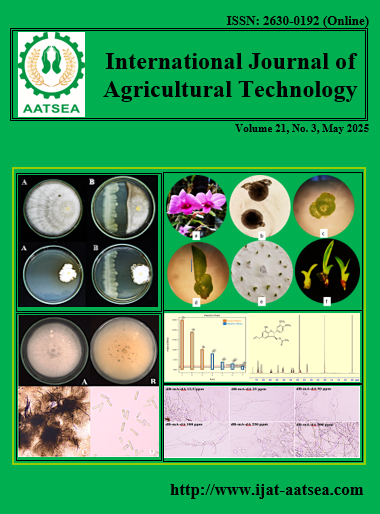Nutritional evaluation of santol (Sandoricum koetjape) and the effects of santol flesh extract on Drosophila melanogaster.
Main Article Content
Abstract
Santol (Sandoricum koetjape) fruit was low in calories and deficient in vitamins B1, B2, and C, but it is a rich source of potassium, containing 156.05-188.48 mg per 100 g. The first filial (F1) generation was observed on the 3rd day after emergence, and survival rates exceeded 90% at all concentrations. In climbing assays, a 100 mg/mL concentration reduced climbing speed over a 10 cm distance by 9.35 times in the P generation and 7.74 times in the F1 generation compared to control. At this concentration, the adult emergence rate decreased to 53%, and body weight in both generations was reduced. However, no difference in body weight was observed at concentrations of 20, 40, 60, and 80 mg/mL compared to controls. These findings indicated that santol fruit is a good source of potassium, but high concentrations of santol extract negatively impact the health and performance of D. melanogaster.
Article Details

This work is licensed under a Creative Commons Attribution-NonCommercial-NoDerivatives 4.0 International License.
References
Baenas, N. and Wagner, A. E. (2022). Drosophila melanogaster as a model organism for obesity and type-2 diabetes mellitus by applying high-sugar and high-fat diets. Biomolecules, 12:307.
Bailly, C. (2022). The health benefits of santol fruits and bioactive products isolated from Sandoricum koetjape Merr.: A scoping review. Journal of Food Biochemistry, 46:e14152.
Chaweerak, S. and Dechakhamphu, A. (2020). Inhibitory effect on lipid accumulation and body weight reaction of rambutan and santol peel extracts in high sugar intake Drosophila melanogaster. KKU Science Journal, 48:521-532.
Gonzalez-Coloma, A., Lopez-Balboa, C., Santana, O., Reina, M. and Fraga, B. M. (2011). Triterpene-based plant defenses. Phytochemistry Reviews, 10:245-260.
He, F. J. and MacGregor, G. A. (2008). Beneficial effects of potassium on human health. Physiologia Plantarum, 133:725-735.
Isman, M. B. (2006). Botanical insecticides, deterrents, and repellents in modern agriculture and an increasingly regulated world. Annual Review of Entomology, 51:45-66.
Kaur, N. and Kocher, D. (2023). Ovicidal, larvicidal and pupicidal potential of neem seed kernel extract against Aedes aegypti L. International Journal of Tropical Insect Science, 43: 1089-1096.
Kim, B. S., Yu, M. Y. and Shin, J. (2024). Effect of low sodium and high potassium diet on lowering blood pressure and cardiovascular events. Frontiers in Genetics, 10:51.
Kleszcz, R., Majchrzak-Celińska, A. and Baer-Dubowska, W. (2023). Tannins in cancer prevention and therapy. British Journal of Pharmacology, 17:1111-16224.
Mirzoyan, Z., Sollazzo, M., Allocca, M., Valenza, A. M., Grifoni, D. and Bellosta, P. (2019). Drosophila melanogaster: A model organism to study cancer. Frontiers in Genetics, 10: 51.
Morton, J. F. (1987). Santol. In: Fruits of Warm Climates, Miami Florida, pp.199-201.
Munnik, C., Xaba, M. P., Malindisa, S. T., Russell, B. L. and Sooklal, S. A. (2022). Drosophila melanogaster: A platform for anticancer drug discovery and personalized therapies. Frontiers in Genetics, 3:949241.
Nassar, Z. D., Aisha, A. F., Idris, N., Khadeer Ahamed, M. B., Ismail, Z., Abu-Salah, K. M., Alrokayan, S. A. and Shah Abdul Majid, A. M. (2012). Koetjapic acid, a natural triterpenoid, induces apoptosis in colon cancer cells. Oncology Reports, 27:727-733.
Pambudi, A. R., Wasiaturrahmah, Y. and Aspriyanto, D. (2021). Antibacterial effectiveness of kecapi sentul extract (Sandoricum koetjape Merr.) against Streptococcus mutans. ODONTO Dental Journal, 8:1-10.
Panchal, K. and Tiwari, A. K. (2017). Drosophila melanogaster “a potential model organism” for identification of pharma - cological properties of plants/ plant - derived components. Biomedicine and Pharmacotherapy, 89:1331-1345.
Poeaim, S. and Pedkland, N. (2024). The biological activities of the methanolic extract of santol (Sandoricum koetjape) fruits. International Journal of Agricultural Technology, 20:749-760.
Puri, S., Singh, S. and Sohal, S. K. (2022). Inhibitory effect of chrysin on growth, development and oviposition behaviour of melon fruit fly, Zeugodacus cucurbitae (Coquillett) (Diptera: Tephritidae). Phytoparasitica, 50:151-162.
Rasadah, M. A., Khozirah, S., Aznie, A. A. and Nik, M. M. (2004). Anti-inflammatory agents from Sandoricum koetjape Merr. Phytomedicine, 11:261-263.
Shi, Y., Pu, D., Zhou, X. and Zhang, Y. (2022). Recent progress in the study of taste characteristics and the nutrition and health properties of organic acids in foods. Foods, 11:3408.
Sujkowski, A. and Wessells, R. (2018). Using Drosophila to understand biochemical and behavioral responses to exercise. Exercise and Sport Sciences Reviews, 46:112-120.
Weaver, C. M. (2013). Potassium and health. Advances in Nutrition, 4:368S-377S.
Wijaya, M. D. (2022). Ethnomedicinal, phytochemicals, and pharmacological aspects of Sentul (Sandoricum koetjape). Biology, Medicine, and Natural Product Chemistry, 11:65-73.


